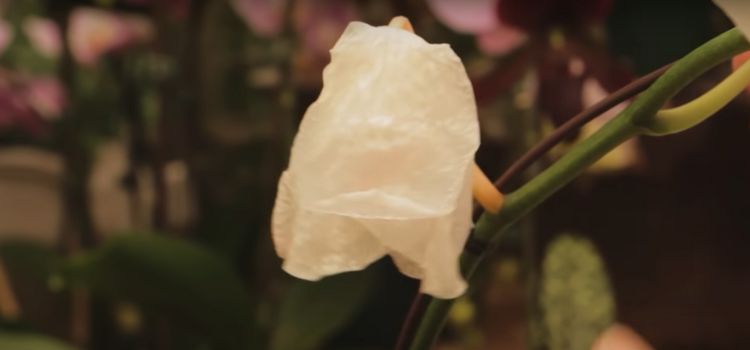As an Amazon Associate, I earn from qualifying purchases.
Orchid flowers may wilt due to underwatering, overwatering, or environmental stress. Poor lighting or temperature fluctuations can also cause wilting.
Orchid enthusiasts often face the challenge of wilting flowers, a sign that their prized plants are in distress. Wilting is one of the orchid’s ways of communicating its needs or discomfort. Providing the right balance of care is crucial, as these delicate flowers require specific amounts of water, light, and warmth to thrive.
Orchids also demand proper humidity levels and well-drained growing mediums.
Common Reasons For Wilting Orchid Flowers
Orchid enthusiasts often see wilting flowers, which can be disheartening. Understanding the root causes is crucial for nurturing these beauties back to health.
Inadequate Watering
Orchids have specific water needs that differ greatly from those of other houseplants. Overwatering and underwatering can cause flowers to wilt.
- Overwatering leads to root rot, starving the plant of oxygen.
- Underwatering dries out roots and deprives the flowers of vital moisture.
To prevent this, ensure your orchid’s potting mix is moist but not soggy. Allow the top inch to dry out before watering again.

Improper Light Conditions
Light is a key factor in orchid health. Orchids thrive in bright, indirect sunlight.
| Light Condition | Impact on Orchids |
|---|---|
| Too much direct sun | Burns leaves and wilts flowers. |
| Insufficient light | Leads to weak growth and wilting blooms. |
Find a spot that simulates the dappled light of their natural habitat for the best results.
Incorrect Temperature
Temperature swings can shock orchids into wilting. These tropical plants prefer a stable environment.
- Maintain daytime temperatures between 65-75°F (18-24°C).
- Keep nighttime temperatures around 60-65°F (15-18°C).
- Avoid placing your orchid near heaters, air conditioners, or drafty windows.
Stable temperatures mimic an orchid’s natural climate and promote healthy flowers.
Pests And Diseases
When orchid flowers wilt, it’s a distress signal. Pests and diseases can harm these delicate blooms. It’s important to identify the culprits early. Prompt action can save your plant and its stunning flowers. Let’s explore common foes in the orchid world.
Presence Of Pests
Pests can be a nightmare for orchid owners. Common invaders include:
- Spider Mites: Tiny and red, they suck sap and cause yellowing.
- Mealybugs: These white fuzzies feast on plant juices.
- Scale Insects: They look like bumps and drain plant nutrients.
- Aphids: Green or black, they’re sap-sucking pests.
To fight pests, isolate the orchid. Use a water spray or insecticidal soap. For harsh infestations, systemic insecticides may be necessary.
Fungal Or Bacterial Infections
Wilting may be due to fungal or bacterial infections. Symptoms to watch for:
| Infection Type | Signs on Orchid | Action |
|---|---|---|
| Root Rot | Mushy, brown roots | Remove compromised roots, repot in fresh media |
| Leaf Spot | Dark, sunken spots on leaves | Trim affected areas, apply fungicide |
For fungal issues, ensure proper airflow and avoid leaf wetness. Use fungicides if needed. Bacteria are trickier, often requiring specialized antibacterial treatments.

Root Problems
Root problems are often the culprit behind wilting orchid flowers. Imagine the roots as the lifeline of your beautiful orchids. They need the right balance of conditions to thrive. When root health suffers, so do the blooms. Let’s dive into the common root issues so we can help those flowers perk up!
Root Rot
Root rot stands as a major threat to orchid health. It usually occurs when roots remain wet for too long. Without the chance to dry properly, roots deteriorate. Signs of this are discoloured, mushy roots and a foul smell. Healthy roots look firm and green. If they are brown and soft, immediate action is needed. Below is a brief guide to address root rot:
- Stop watering your orchid and let the soil dry.
- Remove the orchid from its pot carefully.
- Trim away the damaged roots with sterile scissors.
- Repot into fresh, well-draining growing medium.
- Resume cautious watering after a week.
Root Bound
Root bound happens when orchids outgrow their pots. The roots have no room to expand, forming a tight ball. This can choke the plant, leading to wilted flowers. Orchids need room to grow to stay healthy. If you notice a dense root network peeking out of the pot’s drainage holes, it’s time to repot. Follow these steps to help a root-bound orchid:
- Gently remove the orchid from its current container.
- Prune any dead or overly crowded roots.
- Select a new pot that offers more space.
- Fill with fresh orchid-specific potting mix.
- Place the orchid in the new pot and care for it as usual.
Nutrient Deficiency
Orchid flower wilting can signal a cry for help, specifically a nutrient deficiency. Orchids need a balance of nutrients to thrive, and without them, their vibrant blooms may not last. Understanding the signs and solutions related to nutrient shortfall is key to reviving your orchid’s health.
Lack Of Essential Nutrients
Orchids require a mix of essential nutrients for optimal growth and flower development. Three major nutrients are nitrogen (N), phosphorus (P), and potassium (K). These are the building blocks that support leaf growth, root development, and flowering. When orchids don’t get enough, their flowers may wilt, indicating trouble.
| Nutrient | Function | Sign of Deficiency |
|---|---|---|
| Nitrogen (N) | Leaf growth | Yellowing leaves |
| Phosphorus (P) | Root development | Weak roots, poor bloom |
| Potassium (K) | Flower production | Wilting flowers |
A balance of these nutrients supports a healthy orchid that displays luscious, long-lasting flowers. Missing nutrients can lead to poor health and wilting blooms.
- Check your fertilizer to ensure it’s made for orchids.
- Follow the recommended feeding schedule.
- Monitor your orchid for signs of deficiency.
By providing the necessary nutrients, you can help your orchid flourish and prevent the disheartening sight of wilting flowers.
Potting Issues
Orchids enchant us with their stunning blooms.
Yet, wilted flowers often signal potting mishaps.
Let’s explore how pot-related problems can sap life from these exquisite plants.
Poor Drainage
Orchids thrive in a well-draining environment.
Excessive water spells doom for their delicate roots.
- Ensure the potting mix is loose and airy.
- Select pots with ample drainage holes.
- Avoid letting water sit in saucers under pots.
Avoiding standing water is key.
Container Size
Size matters for orchid pots.
Orchids prefer a snug fit, but overly tight pots choke growth.
| Orchid Size | Ideal Pot Diameter |
|---|---|
| Small | 4-5 inches |
| Medium | 5-6 inches |
| Large | 6 inches or more |
Remember to repot orchids every 1-2 years.

Overfertilization
Overfertilization can be a silent killer for orchids’ vibrant blooms. Understanding the signs is crucial to saving your plants. Let’s explore the problems caused by too much fertilizer and how it leads to wilting orchid flowers.
H2 Accumulation Of Salts/h2
Orchids require nutrients, but excessive fertilizer can lead to an accumulation of salts in the soil. These salts draw out moisture, dehydrating the plant and causing flowers to wilt.
- Root Damage: Roots may appear brown and brittle, a sign of salt damage.
- Leaf Burn: Watch for a crust of fertilizer on the soil surface or signs of burn around leaf edges.
Flush the soil with water to remove excess salts. Then, check the bottoms of the pots for drainage and salt buildup.
H2incorrect Fertilizer Balance/h2
Orchids need a specific fertilizer balance to thrive. The wrong mix can cause flowers to droop and colours to fade.
- Use orchid-specific fertilizers with a balanced N-P-K ratio.
- Apply fertilizer sparingly and according to the orchid type and season.
Refrain from fertilizing when an orchid is dormant to prevent unnecessary stress.
Environmental Stress
Orchid flower wilting can be a sign of environmental stress. Various factors contribute to such conditions. Let’s explore how air quality and humidity levels play a pivotal role.
Air Quality
Poor air quality often leads to wilting orchid flowers. Orchids thrive in clean air, free of pollutants and chemicals. Harmful substances in the air can affect their delicate flowers. These include cigarette smoke, volatile organic compounds from paints, and other harsh substances prevalent in urban environments.
- Ensure ventilation to improve airflow.
- Avoid exposing orchids to smoke and strong fumes.
- Consider an air purifier to maintain quality air around your plants.
Humidity Levels
Appropriate humidity is critical for orchids. These plants are native to tropical climates, where the air is moist. Low humidity can cause flowers to wilt quickly. Conversely, too much moisture leads to fungal growth, which is also harmful.
To maintain optimal humidity:
- Use a humidifier.
- Place a water tray near your orchids.
- Group plants to create a micro-climate.
Monitoring and adjusting these environmental factors will help keep your orchid flowers vibrant and prevent them from wilting.
Frequently Asked Questions
First, check the orchid’s environment and water levels. Ensure proper lighting and humidity. Adjust watering as necessary, avoiding overwatering. For immediate relief, gently stake drooping flowers. Consider repotting if the issue persists.
An overwatered orchid flower often appears wilted and limp and may have a yellow or brown discolouration. The blossoms can also fall off prematurely due to excessive moisture.
Yes, remove wilted orchid flowers to encourage new growth and maintain a tidy appearance. Use sterile scissors to prevent disease.
Orchid flowers may die due to overwatering, insufficient light, extreme temperatures, or nutrient deficiencies. Ensure proper care to prevent this issue.
Conclusion
Understanding the reasons behind wilting orchid flowers is key to reviving your beloved plants. Remember, every orchid speaks its language; learning to interpret it is the gardener’s joy.
Cherish these unfamiliar beauties by nurturing them with attention and knowledge, and they will reward you with their stunning, long-lasting flowers.

